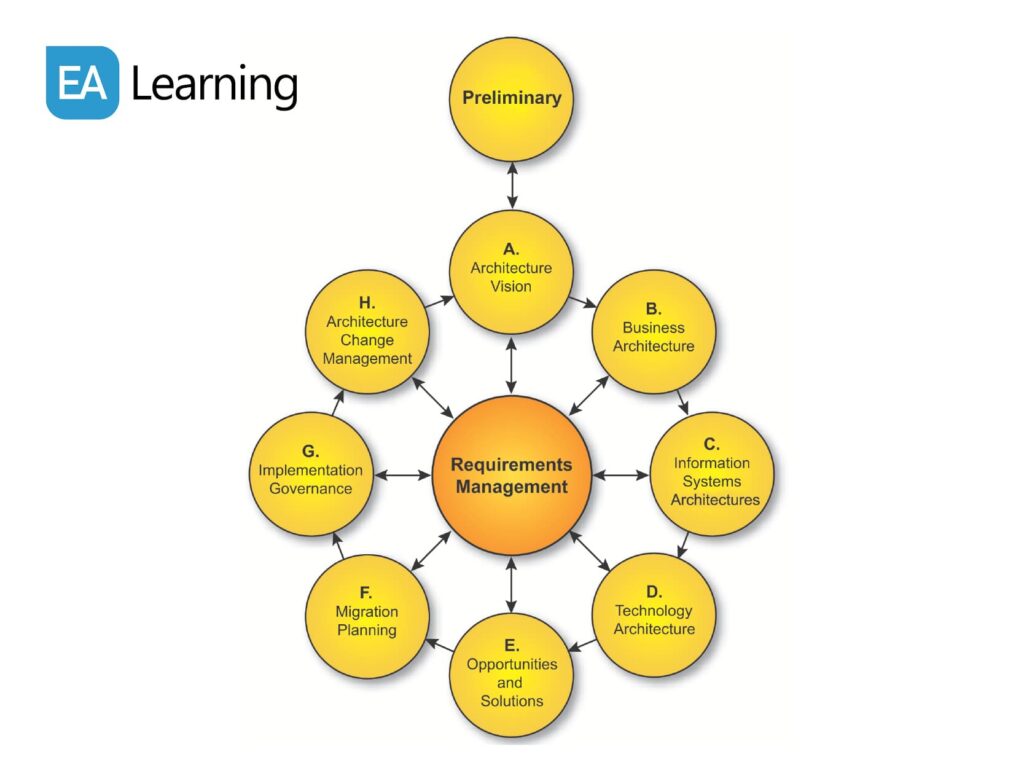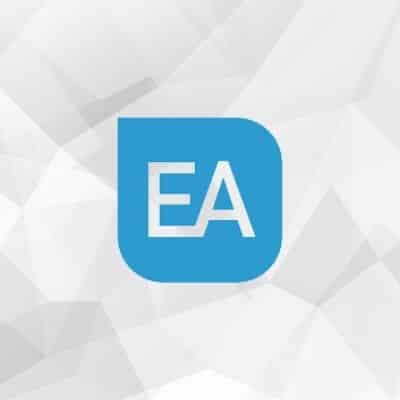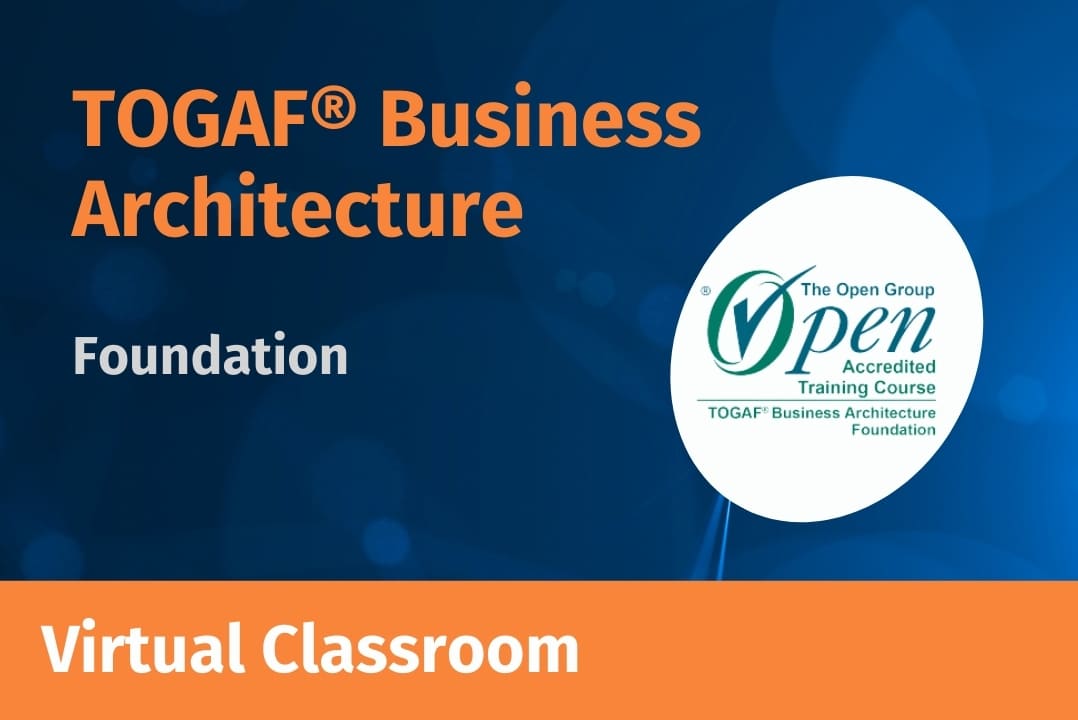The TOGAF® Architecture Development Method (TOGAF® ADM) is the backbone of enterprise architecture, providing a comprehensive and methodical approach to developing an organisation’s architecture that aligns with its business goals and objectives. As the core of the TOGAF® framework, the ADM is not just a theoretical model — it is a proven and adaptable methodology that has been honed over decades of practical applications across diverse industries.
EA Learning has around two decades of experience delivering courses on TOGAF® and enterprise architecture. Our instructors’ expertise empowers professionals and organisations to master the TOGAF® ADM and apply it effectively in their unique business contexts. Our commitment to excellence and real-world applicability ensures that our training not only covers the foundational aspects of TOGAF®, but also delves into how the ADM can be tailored to meet the specific needs of different enterprises. This approach is key to ensuring the architecture developed is not only robust, but also flexible enough to adapt to changing business environments.
Understanding the TOGAF® Architecture Development Method (ADM)
The TOGAF® Architecture Development Method is a structured approach that guides architects through the process of creating, maintaining, and implementing an effective enterprise architecture. The ADM is designed to be iterative and cyclic, allowing for continuous refinement and evolution of the architecture as the business environment and goals change.
The TOGAF® ADM consists of a series of phases, each focusing on a different aspect of the architecture development process. These phases ensure that all aspects of the enterprise architecture are considered and integrated, from the initial vision through to implementation and ongoing management.
The phases of the ADM are:
- Preliminary Phase
- Phase A: Architecture Vision
- Phase B: Business Architecture
- Phase C: Information Systems Architectures
- Phase D: Technology Architecture
- Phase E: Opportunities and Solutions
- Phase F: Migration Planning
- Phase G: Implementation Governance
- Phase H: Architecture Change Management
- Requirements Management (though not a phase per se, it is a critical element that interacts with all phases).

The Importance of Tailoring the ADM
While the TOGAF® ADM provides a robust framework, it is important to recognise that it is not a one-size-fits-all solution. Each organisation has its own unique challenges, goals, and constraints, which means that the ADM must often be tailored to suit the specific needs of the business.
EA Learning emphasises the importance of this tailoring process in its courses. We guide participants through the process of reviewing and adjusting the ADM to better align with their organisational context. This may involve modifying the sequence of the phases, altering the focus of certain phases, or integrating additional steps that are unique to the organisation’s environment.
For example, in some organisations, the preliminary phase might require extensive stakeholder engagement due to the complexity of the enterprise structure, while in others, this phase may be more straightforward. Similarly, the level of detail required in the business architecture phase can vary depending on whether the organisation has a well-defined business strategy or is still in the process of developing one.
The ability to tailor the ADM TOGAF® example to meet specific organisational needs is what makes TOGAF® such a powerful tool in the hands of skilled architects. It allows the architecture to evolve in tandem with the business, ensuring that it remains relevant and valuable as the organisation grows and changes.
Detailed Exploration of TOGAF® ADM Phases
Preliminary Phase
This phase is all about setting the groundwork. It involves defining the architecture framework, principles, and governance structures that will guide the entire architecture development process. This phase also includes gaining approval from key stakeholders, which is critical for ensuring that the architecture initiative has the necessary support and resources.
Phase A: Architecture Vision
In this phase, the focus is on establishing the high-level vision of the architecture, which serves as the foundation for all subsequent phases. The architecture vision should align with the organisation’s strategic goals and provide a clear rationale for the architecture project. It is here that the first set of ADM TOGAF® examples can be created to communicate the value and impact of the architecture to stakeholders.
Phase B: Business Architecture
The business architecture phase is where the detailed design of the business structure is developed. This includes defining business capabilities, organisational structures, and information flows. The goal is to ensure that the business architecture supports the organisation’s strategy and provides a clear blueprint for how the business will operate.
Phase C: Information Systems Architectures
This phase is divided into two parts: Data Architecture and Application Architecture. In this phase, architects define how information and applications will be managed across the organisation to support the business architecture. This includes designing the data models and information flows, as well as identifying the key applications that will be used.
Phase D: Technology Architecture
The technology architecture phase focuses on defining the technical infrastructure that will support the business and information systems architectures. This includes hardware, software, networks, and other IT resources. The goal is to ensure that the technology architecture is scalable, reliable, and capable of supporting the organisation’s current and future needs.
Phase E: Opportunities and Solutions
This phase involves identifying potential opportunities for improving the architecture and developing solution concepts that address these opportunities. This phase is crucial for ensuring that the architecture remains aligned with the organisation’s strategic goals and can adapt to changing business needs.
Phase F: Migration Planning
Migration planning is where the roadmap for implementing the architecture is developed. This includes identifying the key projects and initiatives required to transition from the current state to the desired future state. It also involves developing a detailed timeline and resource plan for implementing the architecture.
Phase G: Implementation Governance
In this phase, the focus is on overseeing the implementation of the architecture. This includes monitoring progress, managing risks, and ensuring that the architecture is implemented in accordance with the defined principles and standards.
Phase H: Architecture Change Management
Architecture change management is about ensuring that the architecture remains relevant and effective over time. This phase involves monitoring the architecture’s performance, managing any changes that need to be made, and ensuring that the architecture continues to support the organisation’s strategic goals.
Requirements Management
Requirements management is a continuous process that interacts with all phases of the ADM. It involves identifying, documenting, and managing the requirements that the architecture must meet. This ensures that the architecture remains aligned with business needs and can adapt to changes in those needs over time.
Why Mastering the TOGAF® ADM Matters
Mastering the TOGAF® Architecture Development Method is crucial for any organisation looking to implement a robust and flexible enterprise architecture. The ADM provides a structured approach that ensures all aspects of the architecture are considered and integrated, from the initial vision through to implementation and ongoing management.
EA Learning understands the importance of not just understanding the ADM, but mastering it. Our TOGAF® EA Foundation and Practitioner course is designed to provide participants with a deep understanding of each phase of the ADM, as well as the skills needed to tailor the method to meet their organisation’s specific needs. This level of focus ensures that the architecture developed is not only aligned with the organisation’s business goals, but also capable of adapting to changes in those goals over time.
Real-World Application of the TOGAF® ADM
One of the key strengths of the TOGAF® ADM is its adaptability. The ADM can be tailored to suit the specific needs of any organisation, regardless of size, industry, or complexity. This makes it a powerful tool for architects looking to develop a robust and flexible enterprise architecture that can adapt to changing business needs.
For example, in a large, multi-national corporation, the ADM might need to be tailored to account for the complexities of operating across different countries and regulatory environments. This could involve adding additional steps to the ADM to address these unique challenges, or modifying existing steps to better align with the organisation’s specific needs.
In contrast, a smaller organisation might focus on streamlining the ADM to ensure that it can be implemented quickly and efficiently. This could involve simplifying certain steps of the ADM, or combining steps to reduce the overall complexity of the architecture development process.
Enquire to Learn More
The TOGAF® Architecture Development Method is a powerful and flexible tool for developing an enterprise architecture that aligns with an organisation’s business goals and objectives. By mastering the ADM, architects can ensure that their organisation’s architecture is robust, flexible, and capable of adapting to changes in the business environment.
EA Learning is committed to helping organisations and professionals master the TOGAF® ADM and apply it effectively in their unique business contexts. Our courses are designed to provide participants with a deep understanding of each phase of the ADM, as well as the skills needed to tailor the method to meet their organisation’s specific needs. Enquire online to learn more about our expertise and how we empower professionals to develop and maintain enterprise architectures that drive business success.



 2 day course
2 day course